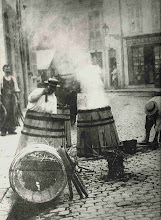Today we are working up the staves we received several weeks ago. For you Francophiles I have included the French term for each step in the process (but really you should get a life).
All of our equipment is designed to run random width staves and staves that have some curve in them. It is more important to follow the grain than to make straight staves.
At each step in the process the staves are graded and any stave not meeting our specification is rejected.
All of our equipment is designed to run random width staves and staves that have some curve in them. It is more important to follow the grain than to make straight staves.
At each step in the process the staves are graded and any stave not meeting our specification is rejected.


Backing (“Dolage”): Planning the exterior of the stave round to match the outside circumference of a barrel. Each Cooperage does things a little different. We chose to do this step first, so that any defects are more visible and, if possible, can be cut out in the end trimming. Some cooperages will do the end trimming as the first step.

End Trimming (“Ecourtage”): The staves are cut to the length of the barrel. All the trimmed off sections of the staves are saved and used in the fires for bending and toasting of the barrels.

Hollowing (“L’evidage”): Planning the interior of the stave round to match the inside circumference of a barrel. A section at each end of the stave is left un-planned. This is where the grove for the head will be cut. This area includes; the chamfer (“Chanfrein”) the angle cut from the end of the barrel, the croze (“Jable”) the grove the head will fit into and the howells (“Pas d asse”) a rounded out section from the end of the chamfer extending past the croze. More on this when get to that process.

Staves waiting for the Jointer, the next step.




